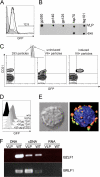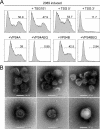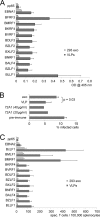A virus-like particle-based Epstein-Barr virus vaccine
- PMID: 21994444
- PMCID: PMC3233152
- DOI: 10.1128/JVI.05598-11
A virus-like particle-based Epstein-Barr virus vaccine
Abstract
Epstein-Barr Virus (EBV) is an ubiquitous human herpesvirus which can lead to infectious mononucleosis and different cancers. In immunocompromised individuals, this virus is a major cause for morbidity and mortality. Transplant patients who did not encounter EBV prior to immunosuppression frequently develop EBV-associated malignancies, but a prophylactic EBV vaccination might reduce this risk considerably. Virus-like particles (VLPs) mimic the structure of the parental virus but lack the viral genome. Therefore, VLPs are considered safe and efficient vaccine candidates. We engineered a dedicated producer cell line for EBV-derived VLPs. This cell line contains a genetically modified EBV genome which is devoid of all potential viral oncogenes but provides viral proteins essential for the assembly and release of VLPs via the endosomal sorting complex required for transport (ESCRT). Human B cells readily take up EBV-based VLPs and present viral epitopes in association with HLA molecules to T cells. Consequently, EBV-based VLPs are highly immunogenic and elicit humoral and strong CD8+ and CD4+ T cell responses in vitro and in a preclinical murine model in vivo. Our findings suggest that VLP formulations might be attractive candidates to develop a safe and effective polyvalent vaccine against EBV.
Figures





Similar articles
-
Epstein Barr Virus: Development of Vaccines and Immune Cell Therapy for EBV-Associated Diseases.Front Immunol. 2021 Oct 8;12:734471. doi: 10.3389/fimmu.2021.734471. eCollection 2021. Front Immunol. 2021. PMID: 34691042 Free PMC article. Review.
-
A novel vaccine candidate based on chimeric virus-like particle displaying multiple conserved epitope peptides induced neutralizing antibodies against EBV infection.Theranostics. 2020 Apr 27;10(13):5704-5718. doi: 10.7150/thno.42494. eCollection 2020. Theranostics. 2020. PMID: 32483413 Free PMC article.
-
Novel Epstein-Barr virus-like particles incorporating gH/gL-EBNA1 or gB-LMP2 induce high neutralizing antibody titers and EBV-specific T-cell responses in immunized mice.Oncotarget. 2017 Mar 21;8(12):19255-19273. doi: 10.18632/oncotarget.13770. Oncotarget. 2017. PMID: 27926486 Free PMC article.
-
Long-term and memory immune responses in mice against Newcastle disease virus-like particles containing respiratory syncytial virus glycoprotein ectodomains.J Virol. 2012 Nov;86(21):11654-62. doi: 10.1128/JVI.01510-12. Epub 2012 Aug 15. J Virol. 2012. PMID: 22896618 Free PMC article.
-
Vaccination against the Epstein-Barr virus.Cell Mol Life Sci. 2020 Nov;77(21):4315-4324. doi: 10.1007/s00018-020-03538-3. Epub 2020 May 4. Cell Mol Life Sci. 2020. PMID: 32367191 Free PMC article. Review.
Cited by
-
EBV-associated diseases: Current therapeutics and emerging technologies.Front Immunol. 2022 Oct 27;13:1059133. doi: 10.3389/fimmu.2022.1059133. eCollection 2022. Front Immunol. 2022. PMID: 36389670 Free PMC article. Review.
-
Engineering extracellular vesicles as novel treatment options: exploiting herpesviral immunity in CLL.J Extracell Vesicles. 2019 Feb 11;8(1):1573051. doi: 10.1080/20013078.2019.1573051. eCollection 2019. J Extracell Vesicles. 2019. PMID: 30788083 Free PMC article.
-
Seroprevalence of cytomegalovirus, Epstein Barr virus and varicella zoster virus among pregnant women in Bradford: a cohort study.PLoS One. 2013 Nov 27;8(11):e81881. doi: 10.1371/journal.pone.0081881. eCollection 2013. PLoS One. 2013. PMID: 24312372 Free PMC article.
-
Vaccines: from empirical development to rational design.PLoS Pathog. 2012;8(11):e1003001. doi: 10.1371/journal.ppat.1003001. Epub 2012 Nov 8. PLoS Pathog. 2012. PMID: 23144616 Free PMC article. Review.
-
Belatacept as a Treatment Option in Patients with Severe BK Polyomavirus Infection and High Immunological Risk-Walking a Tightrope between Viral Control and Prevention of Rejection.Viruses. 2022 May 9;14(5):1005. doi: 10.3390/v14051005. Viruses. 2022. PMID: 35632747 Free PMC article.
References
-
- Ablashi D. V., et al. 1997. Epstein-Barr virus and Kaposi's sarcoma herpesvirus/human herpesvirus 8, p. In (ed.), IARC monograph on the evaluation of carcinogenic risks to humans. International Association for Research on Cancer, Lyon, France
Publication types
MeSH terms
Substances
LinkOut - more resources
Full Text Sources
Other Literature Sources
Research Materials

